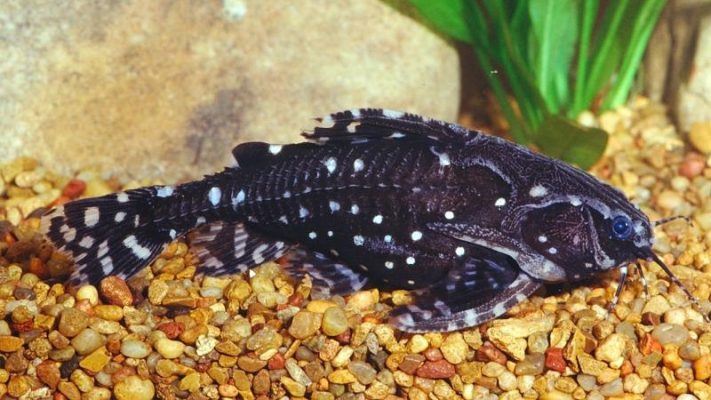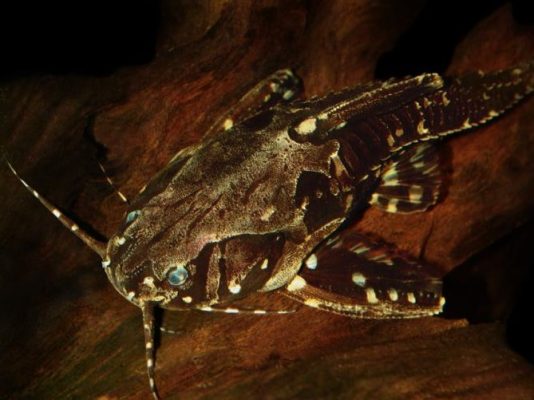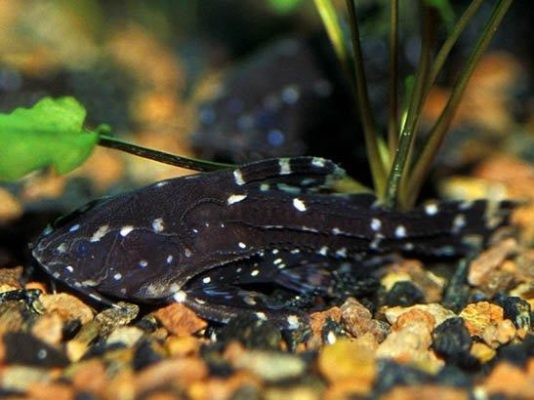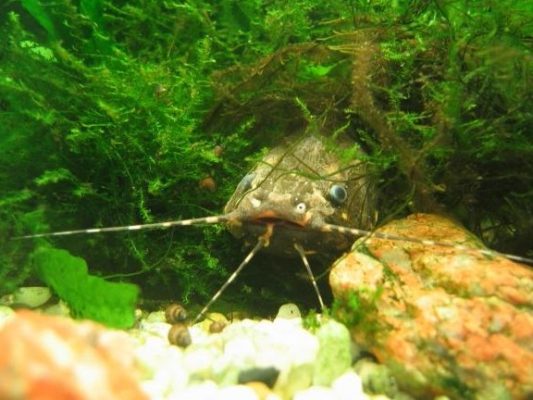Spotted Raphael Catfish

Table of Contents
- Introduction
- Taxonomy and Classification
- Physical Characteristics
- Behavior and Reproduction
- Ecological Role and Importance
- Conclusion
Introduction
The Spotted Raphael Catfish (Agamyxis pectinifrons) is a captivating and highly sought-after species among aquarium enthusiasts. With its unique characteristics and appeal, this catfish species has become a favorite among hobbyists.
This species is known for its distinctive appearance, featuring a sleek body covered in beautiful spots and patterns. The Spotted Raphael Catfish is often admired for its striking coloration, which serves as both camouflage and visual signals in its natural habitat. These features make it a fascinating addition to any aquarium setup.
Furthermore, studying and understanding the Spotted Raphael Catfish is of great importance in terms of its ecological role and conservation. By delving into its behavior, habitat requirements, and care needs, we can ensure successful aquarium keeping and contribute to the preservation of this remarkable species.
Taxonomy and Classification
Description of the Family Heptapteridae to Which the Spotted Raphael Catfish Belongs
The Heptapteridae family, also known as the Three-barbeled catfish family, is a diverse group of catfish species primarily found in freshwater habitats of South America. This family is characterized by the presence of three pairs of barbels on their mouths, which are sensory organs used for locating food and navigating their environment. The name “Heptapteridae” is derived from the Greek words “hepta” meaning “seven” and “pteron” meaning “wing,” referring to the presence of seven rays in the dorsal fin of many species in this family.
Detailed Classification of Agamyxis pectinifrons
The Spotted Raphael Catfish belongs to the genus Agamyxis, which is derived from the Greek words “agamos” meaning “unmarried” and “ixis” meaning “fish.” This genus comprises only one species, Agamyxis pectinifrons, making it monotypic. The species name “pectinifrons” is derived from the Latin words “pectin” meaning “comb” and “frons” meaning “forehead,” referring to the comb-like pattern on its head.
No notable sub-species or variations have been identified within the species Agamyxis pectinifrons. However, individual variations in coloration and pattern can occur, with some specimens exhibiting more intense spotting or variation in the size and arrangement of spots. These variations add to the aesthetic appeal of this species and make each individual unique.
Comparison with Other Related Catfish Species
When comparing the Spotted Raphael Catfish with other catfish species, several unique features and distinctions set it apart.
Firstly, its coloration and pattern make it easily distinguishable. The Spotted Raphael Catfish has a dark brown to black body covered in small white spots, resembling a starry night sky. This distinct pattern serves as camouflage, allowing the fish to blend in with its surroundings and remain hidden from predators.
In terms of physical characteristics, the Spotted Raphael Catfish has a robust body shape with a flattened head and a long, slender caudal fin. It possesses three pairs of barbels, which are longer than the head itself, aiding in sensory perception and food detection. Additionally, the presence of sharp spines on the pectoral and dorsal fins serves as a defense mechanism against potential threats.
Behaviorally, the Spotted Raphael Catfish is known for its nocturnal nature. It is most active during the night, displaying a unique set of behaviors and adaptations to low-light conditions. This includes utilizing its barbels and sensory organs to navigate and locate prey in the darkness. In comparison to other catfish species, the Spotted Raphael Catfish exhibits a more secretive and reclusive behavior, often seeking shelter in crevices or among aquatic vegetation during the day.
In terms of habitat preferences, the Spotted Raphael Catfish is typically found in slow-moving or stagnant freshwater environments, such as rivers, streams, and flooded forests. It prefers areas with ample vegetation cover and submerged structures, providing hiding places and foraging opportunities. This distinguishes it from other catfish species that may inhabit different types of aquatic habitats, such as fast-flowing rivers or deep lakes.
Overall, the Spotted Raphael Catfish stands out among other catfish species due to its unique coloration, nocturnal behavior, and preference for specific habitat conditions. These characteristics make it a fascinating and captivating species for both aquarium enthusiasts and researchers alike.
Physical Characteristics
The Spotted Raphael Catfish (Agamyxis pectinifrons) possesses a range of physical characteristics that contribute to its unique appearance and adaptability. Understanding these features is essential for appreciating the beauty and complexity of this species.
Size and Shape of the Spotted Raphael Catfish
The Spotted Raphael Catfish exhibits a moderate size, with an average length ranging from 4 to 6 inches (10 to 15 centimeters). However, some individuals have been known to grow up to 8 inches (20 centimeters) in length. In terms of weight, they typically weigh between 2 to 4 ounces (56 to 113 grams).
The body of the Spotted Raphael Catfish is elongated and cylindrical, tapering towards the tail. This streamlined shape allows for efficient movement through the water, enabling the catfish to navigate its environment with ease. Additionally, their body is covered in a layer of smooth, scaleless skin, which contributes to their sleek appearance and enables them to glide effortlessly through tight spaces.
Coloration and Patterns on the Body
One of the most striking features of the Spotted Raphael Catfish is its unique spotted pattern and coloration. The body is predominantly dark brown or black, adorned with numerous small, white or yellowish spots. These spots are irregularly distributed across the body, creating a visually captivating mosaic-like pattern.
The spotted pattern serves multiple purposes for the Spotted Raphael Catfish. Firstly, it acts as a form of camouflage, allowing the catfish to blend in with its surroundings, particularly in dimly lit environments. This adaptive coloration helps protect the catfish from potential predators by making it less conspicuous.
Additionally, the spotted pattern may also serve as a visual signal for communication and species recognition. It is believed that the distinctiveness of the pattern allows individuals to identify conspecifics and potentially establish social hierarchies within their groups.
Unique Features such as the Presence of Spines and Barbels
The Spotted Raphael Catfish possesses several unique physical features that set it apart from other catfish species. One notable feature is the presence of sharp, bony spines on the pectoral and dorsal fins. These spines serve as a defensive mechanism, deterring potential predators and providing protection against aggression from conspecifics.
Another distinguishing characteristic of the Spotted Raphael Catfish is the presence of long, slender barbels. These barbels, located around the mouth area, are highly sensitive to touch and play a crucial role in sensory perception. They help the catfish navigate its environment, locate food sources, and detect changes in water conditions.
Furthermore, the Spotted Raphael Catfish possesses a unique adaptation known as an adipose fin. This small, fleshy fin, located on the back, provides additional stability and maneuverability during swimming. While its exact function is not fully understood, it is believed to aid in maintaining balance and control during rapid movements.
In conclusion, the Spotted Raphael Catfish exhibits a range of physical characteristics that contribute to its overall appearance, adaptability, and survival. From its size and shape to its distinctive spotted pattern, presence of spines and barbels, and the unique adipose fin, each feature serves a specific purpose in the catfish’s life. Understanding and appreciating these physical traits adds to the fascination and allure of this captivating species.
Habitat and Distribution
Natural habitat preferences of Agamyxis pectinifrons
The Spotted Raphael Catfish, Agamyxis pectinifrons, primarily inhabits the freshwater habitats of the Amazon River basin in South America. It is specifically known to thrive in slow-moving rivers, tributaries, and flooded forests, which provide ideal conditions for the species.
When it comes to environmental conditions, the Spotted Raphael Catfish shows a preference for slightly acidic to neutral water with a pH range of 6.5 to 7.5. They require water temperatures between 75°F to 82°F (24°C to 28°C) for optimal growth and reproduction. Maintaining stable water parameters is crucial for the health and well-being of this species.
Additionally, the Spotted Raphael Catfish favors areas with moderate water flow. They are often found in regions with gentle currents and abundant vegetation. The presence of submerged plants, fallen branches, and leaf litter provides them with shelter and hiding places, allowing them to feel secure in their environment.
Geographic distribution and range of the species
The Spotted Raphael Catfish is primarily concentrated in the Amazon River basin, spanning across several South American countries including Brazil, Peru, Colombia, and Ecuador. Within this region, they can be found in various tributaries such as the Rio Negro, Rio Solimões, and Rio Madeira.
While the species is native to the Amazon River basin, there have been reports of successful introductions and breeding outside its native range. In some cases, the Spotted Raphael Catfish has been observed in aquariums and fish farms in other parts of the world, including North America and Europe. However, it is important to note that these introduced populations are not as widespread as their native counterparts.
Factors influencing their choice of habitat
Several factors influence the Spotted Raphael Catfish’s choice of habitat. One key factor is food availability. These catfish are primarily carnivorous, feeding on small invertebrates, insects, and crustaceans. They prefer areas with abundant food sources, such as dense vegetation where they can find a variety of prey.
Water quality is another important factor. The Spotted Raphael Catfish thrives in clean, well-oxygenated water. They are sensitive to poor water quality, including high levels of ammonia, nitrites, and nitrates. Maintaining good water quality is essential for their overall health and longevity.
Vegetation cover also plays a significant role in their habitat selection. The presence of submerged plants and fallen branches provides the catfish with hiding places and shelter from potential predators. These areas also serve as hunting grounds, allowing the catfish to effectively ambush their prey.
In conclusion, the Spotted Raphael Catfish is a species with specific habitat preferences. It thrives in slow-moving rivers, tributaries, and flooded forests within the Amazon River basin. They require slightly acidic to neutral water, temperatures between 75°F to 82°F (24°C to 28°C), and moderate water flow. The presence of vegetation and hiding places is crucial for their well-being. Understanding and respecting these habitat preferences is essential for successful aquarium keeping and the conservation of this fascinating species.
Behavior and Reproduction
Nocturnal Behavior and Adaptation to Low-Light Conditions
The Spotted Raphael Catfish, also known as Agamyxis pectinifrons, exhibits fascinating nocturnal behavior and remarkable adaptations to low-light conditions. As a primarily nocturnal species, it is most active during the night, displaying unique behaviors and strategies that allow it to thrive in dimly lit environments.
During the day, the Spotted Raphael Catfish typically seeks shelter in caves, crevices, or under vegetation, where it remains hidden and inactive. As the sun sets and darkness prevails, it emerges from its hiding place and begins its nocturnal activities. This behavioral pattern is believed to be an adaptation to avoid predators and take advantage of reduced competition for resources during the night.
To navigate and locate prey in low-light conditions, the Spotted Raphael Catfish relies on its well-developed sensory system. It possesses highly sensitive barbels, which are long, whisker-like appendages located around its mouth. These barbels are equipped with taste buds and specialized sensory cells that enable the catfish to detect chemical signals in the water, helping it locate food sources and navigate its surroundings.
Furthermore, the Spotted Raphael Catfish has large, well-developed eyes that are adapted to low-light conditions. Its eyes contain a higher density of rod cells, which are specialized photoreceptor cells responsible for detecting low levels of light. This adaptation allows the catfish to effectively perceive its environment and locate prey even in dimly lit areas.
Feeding Habits and Diet
The Spotted Raphael Catfish is a carnivorous species with a diverse diet in the wild. It primarily feeds on small invertebrates, such as insects, crustaceans, and worms. Its diet may also include small fish fry and plant matter, although the latter is consumed in smaller quantities.
In captivity, it is essential to provide a varied and balanced diet to ensure the health and well-being of captive Spotted Raphael Catfish. A suitable diet for these catfish can consist of high-quality pellets or flakes specifically formulated for carnivorous fish. Additionally, offering live or frozen foods, such as bloodworms, brine shrimp, and small crustaceans, can help mimic their natural feeding behavior and provide necessary nutrients.
Maintaining a balanced diet is crucial for the Spotted Raphael Catfish, as it helps prevent nutritional deficiencies and promotes optimal growth and development. It is recommended to feed them small portions multiple times a day, as they have a relatively small stomach capacity and benefit from frequent feeding.
Social Behavior and Interaction with Conspecifics
The Spotted Raphael Catfish is generally a peaceful and social species, exhibiting interesting social behaviors and interactions with conspecifics. In the wild, they are often found in small groups or loose aggregations, where they engage in various social activities.
Within their social groups, the Spotted Raphael Catfish establishes a hierarchical structure, with dominant individuals asserting their authority over subordinate members. This social hierarchy is usually established through displays of aggression, such as fin flaring and chasing, but rarely escalates to physical confrontation.
Interestingly, these catfish also exhibit territorial behavior, especially during the breeding season. Males may establish and defend territories to attract females and protect potential spawning sites. They may engage in territorial displays, such as erecting their dorsal fins and chasing away intruders.
In captivity, it is important to provide adequate space and hiding spots to accommodate their social behavior. Keeping them in groups of three or more individuals is recommended, as it allows them to establish a natural social structure and reduces stress.
Reproductive Strategies and Breeding Habits
The Spotted Raphael Catfish follows a unique reproductive strategy characterized by external fertilization and parental care. During the breeding season, which typically occurs in the warmer months, males actively court females by displaying their vibrant colors, erecting their dorsal fins, and performing courtship dances.
Once a receptive female is identified, the male initiates spawning by nudging her abdomen and leading her to a suitable spawning site. These sites often consist of submerged vegetation or caves, providing a safe and protected environment for the eggs.
The female deposits a cluster of adhesive eggs on the chosen surface, while the male swiftly releases sperm to fertilize them externally. After fertilization, both parents guard the eggs and provide parental care until they hatch. They fan the eggs with their pectoral fins to ensure proper oxygenation and remove any debris or potential threats.
The incubation period for the eggs typically lasts around 4 to 7 days, depending on water temperature and other environmental factors. Once the eggs hatch, the fry are initially attached to the spawning site by an adhesive organ called a yolk sac, which provides them with essential nutrients. After absorbing the yolk sac, the fry become free-swimming and begin to explore their surroundings.
Successful breeding of the Spotted Raphael Catfish in captivity requires providing suitable spawning sites, maintaining optimal water parameters, and ensuring a balanced diet for the parents. Breeding these catfish can be a rewarding experience for dedicated aquarium enthusiasts, as it contributes to the conservation of this captivating species.
In conclusion, the Spotted Raphael Catfish showcases intriguing behavior and reproductive strategies that have evolved to maximize their survival in their natural habitat. Understanding their nocturnal behavior, feeding habits, social interactions, and breeding habits not only enhances our appreciation for this species but also assists in the development of effective conservation and aquarium management practices. By providing the necessary care and attention to their specific needs, we can contribute to the long-term preservation of the Spotted Raphael Catfish and ensure its continued presence in the aquarium trade.
Ecological Role and Importance
The Spotted Raphael Catfish (Agamyxis pectinifrons) plays a crucial ecological role in its natural habitat, contributing to the balance and functioning of its ecosystem. Understanding the species’ impact on its environment is essential for effective conservation and management strategies. In this section, we will delve deeper into the ecological role of the Spotted Raphael Catfish, its relationships with other species, and the conservation concerns associated with its habitat.
Impact of the Spotted Raphael Catfish on their ecosystem
The Spotted Raphael Catfish occupies an intermediate position in the food chain of its ecosystem. As a primarily nocturnal predator, it feeds on a variety of small invertebrates, including insects, crustaceans, and worms. By regulating the populations of these prey species, the Spotted Raphael Catfish helps maintain ecological balance and prevent overpopulation of certain organisms. This predatory behavior is particularly important in controlling populations of potential pests or disease vectors.
Furthermore, the Spotted Raphael Catfish contributes to nutrient cycling within its habitat. As it consumes prey items, it releases nutrients through excretion and decomposition processes. These nutrients are then made available to other organisms in the ecosystem, supporting the growth of primary producers and facilitating the transfer of energy through the food web. In this way, the Spotted Raphael Catfish plays a vital role in nutrient dynamics and the overall productivity of its ecosystem.
Relationship with other species in their habitat
The Spotted Raphael Catfish engages in various relationships with other species in its habitat, both predator-prey and symbiotic in nature. As a predator, it influences the population dynamics of its prey species, exerting selective pressure that can drive adaptations and shape the evolutionary trajectories of these organisms. Conversely, the Spotted Raphael Catfish may also fall prey to larger predators, such as larger fish or aquatic birds, highlighting the interconnectedness of species within the ecosystem.
In addition to predator-prey interactions, the Spotted Raphael Catfish forms symbiotic relationships with certain species. For instance, it has been observed that some small fish species may seek shelter among the spines of the catfish, benefiting from the protection provided by its armored body. This mutualistic association allows the smaller fish to avoid predation and utilize the catfish’s defensive adaptations for their own survival.
Potential ecological threats or conservation concerns
Despite its ecological importance, the Spotted Raphael Catfish faces several threats to its habitat and population. Habitat destruction, primarily due to deforestation and the conversion of natural areas into agricultural or urban landscapes, poses a significant risk. The loss of suitable habitats can disrupt the Spotted Raphael Catfish’s ability to find suitable spawning sites and impact its overall reproductive success.
Pollution, including the discharge of agricultural runoff and industrial waste into water bodies, also poses a threat to the species. Elevated levels of pollutants can negatively affect the Spotted Raphael Catfish’s health and reproductive capabilities, as well as the quality of its habitat. Additionally, overfishing for the aquarium trade or for consumption purposes can deplete populations and disrupt the ecological balance in which the species plays a vital role.
To address these conservation concerns, ongoing efforts are being made to protect the Spotted Raphael Catfish and its habitat. Conservation organizations and initiatives focus on raising awareness about the species, promoting sustainable fishing practices, and advocating for the preservation of its natural habitats. Additionally, the establishment of protected areas and the implementation of habitat restoration projects aim to safeguard the Spotted Raphael Catfish and ensure the long-term viability of its populations.
In conclusion, the Spotted Raphael Catfish is a species of ecological significance, contributing to the balance and functioning of its ecosystem. Its role as a predator and nutrient contributor, as well as its relationships with other species, highlights its importance in maintaining the health and stability of its habitat. However, habitat destruction, pollution, and overfishing pose significant threats to the species. By understanding its ecological role and implementing conservation measures, we can work towards preserving the Spotted Raphael Catfish and the integrity of its ecosystem for future generations.
Conclusion
The Spotted Raphael Catfish (Agamyxis pectinifrons) is a fascinating and popular species among aquarium enthusiasts. Throughout this article, we have explored the various aspects of its biology, behavior, and conservation, highlighting its unique characteristics and importance.
The Spotted Raphael Catfish belongs to the family Heptapteridae, which is known for its diversity and distinct characteristics. Within this family, the Spotted Raphael Catfish stands out with its distinct physical features, including its size, shape, and coloration. Its body is adorned with unique spotted patterns, serving as both camouflage and visual signals.
This species is native to the Amazon River basin in South America, where it thrives in specific environmental conditions such as water temperature, pH levels, and water flow. Understanding its natural habitat preferences is crucial for successful aquarium keeping and conservation efforts.
The Spotted Raphael Catfish exhibits interesting behaviors, including its nocturnal nature and adaptation to low-light conditions. Its diet consists of various prey in the wild, and it is important to provide a balanced diet for captive individuals. Socially, this species interacts with conspecifics, displaying territorial or hierarchical behaviors.
In terms of its ecological role, the Spotted Raphael Catfish plays an important part in its ecosystem. It occupies a specific position in the food chain and has an impact on prey populations. Additionally, it engages in various interactions with other species, including predator-prey and symbiotic relationships.
However, the Spotted Raphael Catfish faces potential threats to its habitat and population, such as habitat destruction, pollution, and overfishing. Conservation efforts and initiatives are crucial to protect this species and its habitat. Supporting conservation organizations and practicing responsible aquarium keeping can contribute to its long-term survival.
Scientific studies have provided valuable insights into the biology and behavior of the Spotted Raphael Catfish. However, there are still research gaps that need to be addressed to enhance our understanding of this species. Further research can contribute to conservation efforts, habitat management, and captive breeding programs.
In conclusion, the Spotted Raphael Catfish is a captivating species that offers both rewards and challenges for aquarium enthusiasts. Its unique characteristics, ecological role, and conservation significance make it a valuable addition to any aquarium setup. By supporting research and conservation efforts, we can ensure the continued survival and appreciation of this remarkable species.



